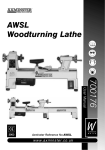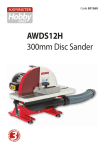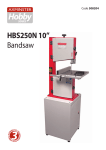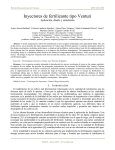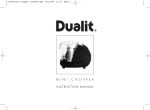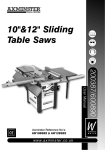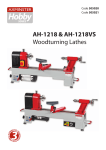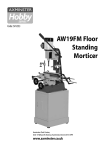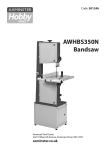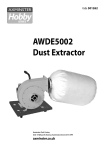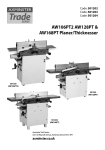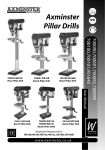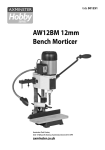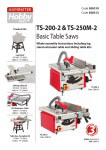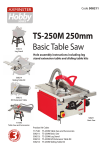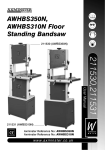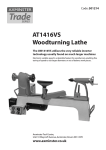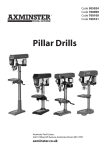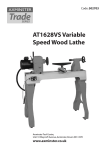Download Axminster AWSL Instruction manual
Transcript
Code 501245 AWSL Woodturning Lathe Hole assembly instructions including extension bed OPTIONAL EXTENSION BED Code 503035 Axminster Tool Centre, Unit 10 Weycroft Avenue, Axminster, Devon EX13 5PH axminster.co.uk Index of Contents Page No. Index of Contents Declaration of Conformity What’s in the Box General Instructions for 230V Machines Specific Safety Instructions for Woodturning Lathes Specification Initial Assembly Parts Description and Identification Changing the Speed Parts Breakdown/List Notes 02 02 03 03-04 04-05 05 05-06 07-08-09-10 11 12-13-14 15 Declaration of Conformity Copied from CE Certificate The undersigned, F. Mocking authorised by Laizhou Chunlin Machinery Factory No. 275 Wenquan East Road Laizhou,Shandong 261400 P.R. China declares that this product manufactured by Laizhou Chunlin Machinery Factory is in compliance with the following standards or standardisation documents in accordance with Council Directives 93/68/EEC Model number MC1018 (Wood Lathe) Please read the Instruction Manual prior to using your new machine; as well as the operating procedures for your new machine, there are numerous hints and tips to help you to use the machine safely and to maintain its efficiency and prolong its life. Keep this Instruction Manual readily accessible for any others who may also be required to use the machine. symbols below advise that you follow the correct Warning The safety procedures when using this machine. Fully read manual and safety instructions before use 02 Ear protection should be worn Eye protection should be worn Dust mask should be worn HAZARD Motor gets hot What’s in the Box Quantity Item Model Number Box 1 MC1018 AWSL Lathe Headstock and Tailstock fitted Toolrest Arm Fitted to lathe bed 140mm Tool rest Fitted to Toolrest arm 80mm Faceplate Fitted to Headstock Packet containing:4 Prong Drive Centre Revolving Centre Handle for Tailstock Adjusting Wheel Rubber Feet with integral M8 bolts (for use with the Bed Extension) Flat Washers Spring Washers 8mm Allen Key 6mm Allen Key 3mm Allen Key Instruction Manual Guarantee Card Box 2 AWSL Bed Extension (OPTIONAL) Instruction Leaflet Bolts 1 No. 1 No. 1 No. 1 No. 1 No. 1 No. 1 No. 1 No. 2 No. 2 No. 2 No. 1 No. 1 No. 1 No. 1 No. 1 No. 1 No. 1 No. 2 No. Having unpacked your new AWSL woodturning lathe please dispose of the unwanted packaging responsibly. The cardboard packaging is biodegradable. General Instructions for 230V Machines Good Working Practices/Safety The following suggestions will enable you to observe good working practices, keep yourself and fellow workers safe and maintain your tools and equipment in good working order. ! WARNING!! KEEP TOOLS AND EQUIPMENT OUT OF THE REACH OF YOUNG CHILDREN Primary Precautions These machines are supplied with a moulded 13 Amp. Plug and 3 core power cable. Before using the machine inspect the cable and the plug to make sure that neither are damaged. If any damage is visible have the tool inspected/repaired by a suitably qualified person. If it is necessary to replace the plug, it is preferable to use an ‘unbreakable’ type that will resist damage. Only use a 13 Amp plug, and make sure the cable clamp is tightened securely. Fuse as required. If extension leads are to be used, carry out the same safety checks on them, and ensure that they are correctly rated to safely supply the current that is required for your machine. 03 General Instructions for 230V Machines Work Place/Environment Make sure when the machine is placed that it sits firmly on the bench or stand, that it does not rock, that it is sufficiently clear of adjacent obstacles so that you have unimpeded access to all parts of the machine. The machine is designed for indoor use, do not use when or where it is liable to get wet. Keep the machine clean; it will enable you to more easily see any damage that may have occurred. Clean the overall machine with a damp soapy cloth if needs be, do not use any solvents or cleaners, as these may cause damage to any plastic parts or to the electrical components. Clean the machined components with a lightly oiled cloth. If the machine is liable to be standing idle for any length of time a light coat of machine or spray oil will minimise rusting. ! Keep the work area as uncluttered as is practical, this includes personnel as well as material. Under no circumstances should CHILDREN be allowed in work areas. It is good practice to leave the machine unplugged until work is about to commence, also make sure to unplug the machine when it is not in use, or unattended. Always disconnect by pulling on the plug body and not the cable. Once you are ready to commence work, remove all tools used in the setting operations (if any) and place safely out of the way. Re-connect the machine. Carry out a final “tightness” check e.g. chuck or face plate, workpiece, tool rest, etc., check that the correct speed has been selected. Make sure you are comfortable before you start work, balanced, not reaching etc. If the work you are carrying out is liable to generate flying grit, dust or chips, wear the appropriate safety clothing, goggles, gloves, masks etc. If the work operation appears to be excessively noisy, wear ear-defenders. If you wear your hair in a long style, wearing a cap, safety helmet, hairnet, even a sweatband, will minimise the possibility of your hair being caught up in the rotating parts of the tool, likewise, consideration should be given to the removal of rings and wristwatches, if these are liable to be a ‘snag’ hazard. Consideration should also be given to non-slip footwear, etc. Do not work with cutting tools of any description if you are tired, your attention is wandering or you are being subjected to distraction. A deep cut, a lost fingertip or worse; is not worth it! Above all, OBSERVE…. make sure you know what is happening around you, and USE YOUR COMMON SENSE. Specific Safety Instructions for Woodturning Lathes 1. Do not use ‘split’ work pieces. 2. Always start at the lowest speed when starting a new task. 3. Try to render a new workpiece “round” (or as close as is practical) before turning. 4. Check that the tool rest is at or slightly below the centre line of the workpiece. 5. Check the workpiece is securely mounted in the lathe before switching on the power. 6. Rotate the workpiece by hand, to check that it is:- centralised, clear of the tool rest, not ‘split’ or has loose knots. 7. Where lathes have the facility to be reversed; check the machine is rotating in the correct direction. 8. If your lathe has the facility to run in reverse, you must ensure that the mounting accessories (chucks, faceplates etc.,) can be ‘locked’ onto the lathe mandrel, and in the case of chucks have some form of security device to prevent them ‘unwinding’ during reverse operation. 04 Specific Safety Instructions for Woodturning Lathes 9. Make sure your tools are stored/racked away from the turning area of the lathe. Do not reach over a rotating workpiece at any time. 10. Do not ‘dig in’ or try to take too large a cut. 11. Do not leave the lathe running unattended; or leave the machine until everything is stopped. 12. If you are turning between centres with ‘softish stuff’, check and reposition the tailstock centre frequently. 13. Some turning tools may have specific sharpening angles that have been determined by the manufacturers; when re-sharpening, adhere to these angles to maximise the finish of your work. Specification Model Product Code Rating Power Speed Spindle Taper Spindle Thread Taper Tailstock Distance Between Centres Max Diameter over Bed Overall L x W x H Weight AWSL 501245 Hobby 375W (5) 760-3,200rpm 2MT 1” x 8tpi (Ref T04M) 2MT 440mm(17”), 965mm (38”) with extension 240mm 865 x 205 x 365mm 38kg Initial Assembly Before commencing assembly, please read the parts description & identification so that you can readily identify the parts. Remove the lathe from its packaging. Stand it on the bench. Loosen the banjo lock and reposition to the required position, similarly with the tool rest. Locate the handle for the tailstock control wheel and screw securely into the pre-threaded hole in the wheel rim flange, using a flat blade screwdriver. If you are going to fit the optional bed extension, follow the instructions that are in the box or see page 06. 05 Initial Assembly Optional Extension Bed Step 2 Remove the plate and locate the holes. Step 1 Remove the two screws. Bolt holes Screw driver Dowel holes Typ. dowels Step 3 Line up the extension bed locating dowels with the two dowel holes in the casting. Step 5 Clamp the tailstock across the join to align the beds. Then tighten the holding bolts securely. 06 Step 4 Slide the extension bed carefully but firmly into place. Insert the bolts and tighten, finger tight. Step 6 Refit end cover plate to extension bed. Wood lathe Extension bed Parts Description and Identification AWSL Front View Faceplate Drive centre Headstock spindle handle Tailstock handle Headstock Tailstock Revolving Centre Banjo Lathe bed Banjo lock On Off Motor assembly Shaped handle On/off Switch 07 Parts Description and Identification Lathe Bed Cast Iron frame with ground top surfaces and 4 leg extrusions, the leg extrusions have large rectangular flanges for strength and are also used to support the ON/OFF switch assembly at the tailstock end and the motor mounting plate, drive pulley assembly at the headstock end. There are threaded holes in the base of the legs to accept the integral bolts of the rubber feet. The far headstock end has a flat metal plate cover to guard the drive pulley cluster. The far tailstock end has four threaded holes to accept the mounting bolts for the optional bed extension. If the bed extension is not used the mounting face is covered by a small metal plate (secured by 2 screws, which also have threaded fixing holes in the end of the bed). The metal plate also prevents the tailstock being slid off the end of the bed. If the bed extension is fitted, the plate should be transferred to the end of the extension. Headstock Tower casting, which is bolted to the bed. It has housings for the bearings that carry the headstock spindle. At the rear of the headstock is an open void to give access to the driven pulley cluster, it is guarded by a flat metal plate cover. Headstock Spindle A steel spindle threaded 1” UNC (8 tpi) to mount faceplates, chucks etc. The spindle is bored out to accept 2MT drive centres et al. The driven pulley cluster is keyed onto the shaft between the two mounting bearings. There is a small handwheel mounted on the outer end of the spindle to facilitate hand rotation, whilst setting work up, changing speed etc. Motor Assembly The motor is mounted on a plate which is shaped to provide a pivot point on one side and a handle shape on the other. There is a radius slot on the handle side through which a clamping bolt is fitted. The clamping bolt (with a washer) fits through the motor plate and into a threaded hole in the bed leg flange casting, and when tightened will clamp the motor plate in position to maintain tension on the drive belt. The drive pulley cluster is mounted on the motor shaft, and is accessed through the cover plate on the bed. Banjo 08 The toolrest mounting arm. This is a shaped cast iron casting, the base of which is machined to lay flat across the bed of the lathe. The ‘mound’ at the end of the casting has a machined hole to accept the stem of the toolrest. There is also a threaded hole through the ‘mound’ into the hole, which has a lift and shift lever handle bolt inserted into it, to screw against the stem of the toolrest, in order to clamp it in position. The main body of the casting has a long, lever ended actuating rod though it, the lever end protruding beneath the ‘mound’, the other end held in place by a circlip. The actuating rod performs a cam lift action on a pendant bolt. The pendant bolt hangs between the two bed surfaces and carries the clamping dog. The underside of the main body is slotted along its length to allow it to be slid back and forth about the pendant bolt in order to position it. When the cam lift is operated the clamping dog pulls up against the underside of the bed and holds the banjo in its set position. The clamping dog is adjusted using the nut on the pendant bolt. Parts Description and Identification AWSL Rear View Tailstock barrel lock Revolving centre Toolrest Tailstock Toolrest lock Tailstock lock Motor Tailstock handle Access panel Pivot bolt 09 Parts Description and Identification Toolrest A stright stem with a shaped cast metal blade forming a ‘T’ profile. It fits into the banjo, and is locked in position for height and approach angle to support the turning tools being used on the workpiece. Tailstock This casting has a machined base which locates in the slot between and sits across the two surfaces of the bed. There is a similar mechanism (cam lift) to that fitted to the banjo to lock the tailstock in position. The upper part of the casting carries the tailstock barrel, the centreline of which is in line with the headstock centreline. The barrel can be advanced or returned using the control wheel. The barrel can be held in position using its lock (a lift and shift handled lever bolt) which pinches the barrel in the casting. The barrel is bored to accept 2MT tools. On/Off switch assembly Standard on/off switch assembly, with ‘I’ indicating the on button and ‘O’ indicating the off button. The switch is NVR. 10 Changing the Speed Note. The lowest speed pulley combination is furthest from the faceplate, i.e. smallest motor pulley diameter to largest spindle pulley diameter. ! Disconnect the machine from the mains supply Locate the two cover plates at the end and at the rear of the headstock. Loosen the ‘star nuts’ that secure the cover plates, see figs (A,B) lift, slide, turn…etc. them out of the way to give you access to the belt. Using the 6mm Allen key supplied, loosen the clamping bolt behind the shaped handle of the motor plate, see fig (C). (You may need to slightly loosen the pivot bolt on the other side of the motor plate as well). Lift the motor plate up to give enough slack in the belt to enable it to be moved to the new selection. When the belt is located, turn the spindle to ensure the belt is correctly seated. (Check that the belt is vertical, the belt must not be run out of vertical Cover plate alignment, this can cause the belt to ‘jump’ the pulley grooves, possibly the wrong way, and if it does manage to run, it will scuff the sides of the belt badly). When you are sure all is correct, press down on the motor plate handle to put tension on the belt. (Don’t go mad, the belt does not need to be bar taut to operate correctly). Tighten up the clamping bolt to hold the motorplate in position. Replace/refit the cover plates. Reconnect the machine to the mains supply. Give the lathe a little ‘burst’ to check it all runs smoothly. When you are satisfied, remove any tools you may have been using; stow carefully away. The lathe is now ready to be used again. A B Star screws Belt Spindle Belt C Clamping bolt Shaped handle 11 Parts Breakdown/LIst 12 Parts Breakdown/LIst 13 Parts Breakdown/LIst 14 Notes 15 Please dispose of packaging for the product in a responsible manner. It is suitable for recycling. Help to protect the environment, take the packaging to the local recycling centre and place into the appropriate recycling bin. Only for EU countries Do not dispose of electric tools together with household waste material. In observance of European Directive 2002/96/EC on waste electrical and electronic equipment and its implementation in accordance with national law, electric tools that have reached the end of their life must be collected separately and returned to an environmentally compatible recycling facility.
















